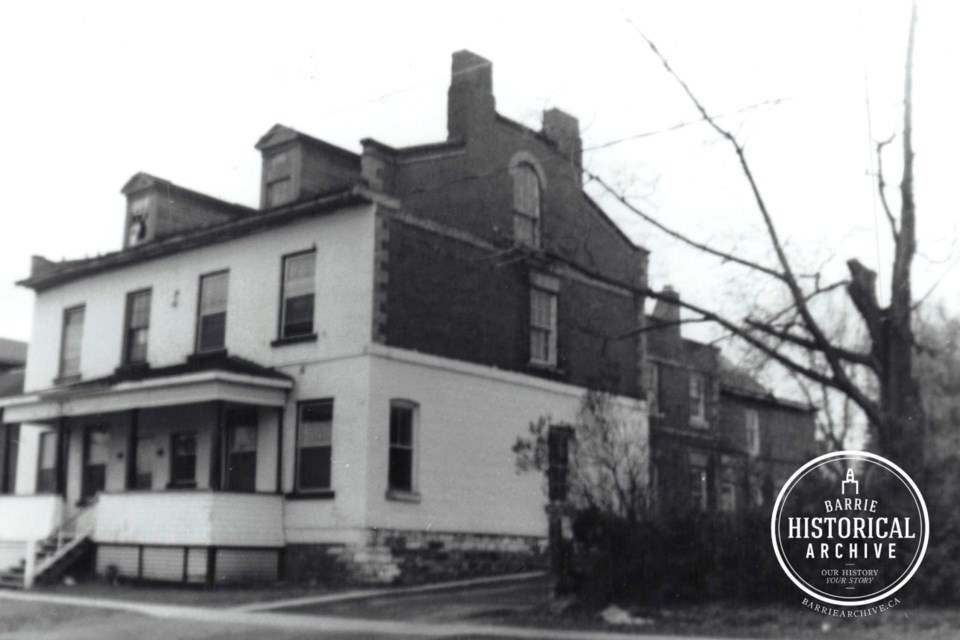This ongoing series from Barrie Historical Archive curator Deb Exel shows old photos from the collection and one from the present day, as well as the story behind them.
Dutton House – 30 Mary St.
One of the few surviving heritage buildings of lower Mary Street, this handsome Victorian home is believed to have been built in 1874, by renowned Barrie architect Thomas Kennedy, for Barrie’s first mayor (1871), Robert Simpson.
Simpson, a brewer by trade, had operations in the villages of Tollendal and Kempenfelt about 1843. A fire at the Tollendal brewery prompted a business move to Barrie, where Simpson built his Simcoe Steam Brewery at the bottom of Mary Street, around 1848.
Records show that Barrie merchant R.A. Dutton purchased the property in 1890 – some accounts believe that it was Dutton who built this elegant residence. Robert Austin ‘R.A.’ Dutton, was born in Longton, England in 1854, coming to Canada when he was 16 years old. In his youth, in the 1870s, R.A. Dutton was a skilled oarsman and competed in the regattas on Kempenfelt Bay, sharing the water with the likes of Ned Hanlan.
Dutton went into the grocery business as a young man – at the time of his death in 1919, he was thought to be one of the oldest grocers in Ontario. It’s possible he got his start with J & D Farquharson, "dealers in groceries and provisions, wines and liquors, china, crockery and glassware, coal oil, lamps etc. Located in the centre brick block, south side of Dunlop Street."
Farquharson’s had been in business since at least the early 1870s when Dutton himself entered the grocery world, and eventually the two would go into business together. Donald Farquharson would be a witness at Robert’s marriage to Esther (Ettie) Hazeldina Cullen, of Innisfil, in July of 1880.
In 1881, a notice appeared in the local papers, a "Dissolution of Partnership Discount Sale. Now going on to clean out present stock at Farquharson and Dutton."
Farquharson and Dutton went their separate ways. Robert opened his own shop at the eastern edge of the Ontario Block, on the north side of Dunlop Street East, east of Five Points. Dutton actively promoted his business at 28 Dunlop St.:
“R.A. Dutton takes the lead! In crockery, printed tea sets and fancy toilet sets a specialty. A full stock of woodenwares. Churns in their sizes, butter tubs in their sizes, bowls ladles and prints, brooms and washtubs. Groceries of first quality, at low prices.”
“R.A. Dutton has just received a large lot of maple syrup at $1.25 per gallon. Dried sweet corn, turkey, prunes, marmalade and sweet oranges. Fine old government Java coffee. Fine teas a specialty.”
“R.A. Dutton keeps a full supply of fresh fruits, dried fruit, canned fruits, canned fish of all kinds, corned beef and potted meats. Butters, butters, butters. Sugars, sugars, sugars. Teas, tea, teas.”
Business was clearly going well for Dutton, allowing him to pursue his keen interest as a horseman, racing horses, maintaining a membership in the Barrie Turf Club, and serving on the executive of the Barrie Lacrosse team. It wasn’t entirely all business and the sporting life for Dutton, however. He was also an active member of the public school board and other municipal positions.
After 26 years, Dutton sold his grocery in Barrie and moved to Peterborough for 11 years before relocating his business to Toronto, where he worked until his death. His wife Ettie survived him by 32 years. The couple are buried in Barrie Union Cemetery.
So, if the house built by Simpson is the Dutton House, is there a Simpson House?
Simpson purchased property on Mary Street, north of his brewery, where he had his first home built, around 1855. This dwelling at 26 Mary St., the Robert Simpson House, was possibly built by John Pearson, an English builder who constructed the Frederic Gore (Grammar School headmaster) house at 47 Rodney St. and who was a subcontractor on the building of the courthouse in the early 1840s. Pearson’s own house, quite a magnificent home in its time and a neighbour to the Simpsons, still stands today at 16-18 Mary St.
The Robert Simpson House was what is referred to today as a ‘semi-detached’ dwelling – two separate residences, with Simpson and his family living in the north half of the building. The original house was two and a half storeys with no basement, but the home saw several additions and changes in the years that followed.
Sadly, the Robert Simpson house, one of the city’s oldest buildings, was demolished in 1984 to create a municipal parking lot.
While not every heritage structure can be saved, they can be photographed and documented, preserving a record of these buildings for historical purposes. The East Georgian Bay Historical Foundation published a lengthy and astonishingly detailed architectural study of the Simpson House, conducted prior to and throughout the demolition process.
The report describes in great depth, just to name a few features, the floor plans, building materials, brick patterns, split fieldstone foundation, fireboxes and chimneys, ironwork, parapet walls, uses of space in the home and even the 1858 furnishings based on a tenant’s sale at the time. It’s a fascinating brick-by-brick, board-by-board account of the construction, or deconstruction as it were, of a mid-1850s home. Truly a remarkable insight to the architectural styles and techniques of the past.
Fortunately, Dutton House continues to stand. The current owners are invested in conserving Barrie’s past, its heritage and historic downtown and have committed to preserving Dutton House as an important part of the community. Their dedication to 30 Mary St. is obvious, given the outstanding restoration and ongoing care to this gracious building. Dutton House is a designated property under the Ontario Heritage Act and the recent recipient of a Heritage Award from Heritage Barrie.



